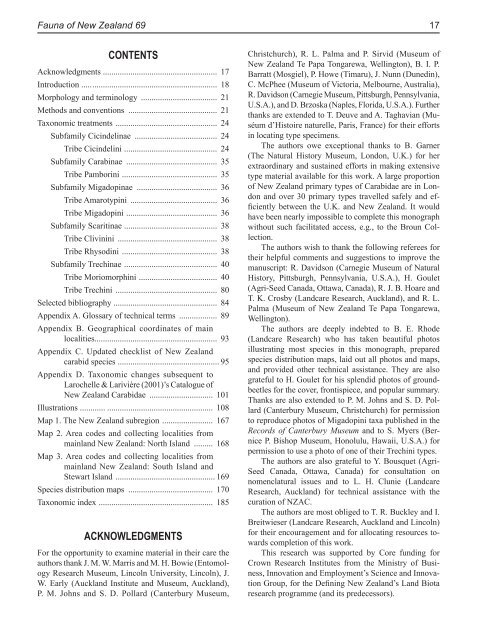Fauna of New Zealand 69 - Landcare Research
Fauna of New Zealand 69 - Landcare Research
Fauna of New Zealand 69 - Landcare Research
You also want an ePaper? Increase the reach of your titles
YUMPU automatically turns print PDFs into web optimized ePapers that Google loves.
<strong>Fauna</strong> <strong>of</strong> <strong>New</strong> <strong>Zealand</strong> <strong>69</strong> 17<br />
CONTENTS<br />
Acknowledgments ...................................................... 17<br />
Introduction ..... ........................................................... 18<br />
Morphology and terminology .................................... 21<br />
Methods and conventions .......................................... 21<br />
Taxonomic treatments ................................................ 24<br />
Subfamily Cicindelinae ....................................... 24<br />
Tribe Cicindelini ............................................ 24<br />
Subfamily Carabinae ........................................... 35<br />
Tribe Pamborini ............................................. 35<br />
Subfamily Migadopinae ...................................... 36<br />
Tribe Amarotypini ......................................... 36<br />
Tribe Migadopini ........................................... 36<br />
Subfamily Scaritinae ............................................ 38<br />
Tribe Clivinini ............................................... 38<br />
Tribe Rhysodini ............................................. 38<br />
Subfamily Trechinae ............................................ 40<br />
Tribe Moriomorphini ..................................... 40<br />
Tribe Trechini ................................................ 80<br />
Selected bibliography ................................................. 84<br />
Appendix A. Glossary <strong>of</strong> technical terms .................. 89<br />
Appendix B. Geographical coordinates <strong>of</strong> main<br />
localities.......................................................... 93<br />
Appendix C. Updated checklist <strong>of</strong> <strong>New</strong> <strong>Zealand</strong><br />
carabid species ................................................ 95<br />
Appendix D. Taxonomic changes subsequent to<br />
Larochelle & Larivière (2001)’s Catalogue <strong>of</strong><br />
<strong>New</strong> <strong>Zealand</strong> Carabidae .............................. 101<br />
Illustrations ............ .................................................. 108<br />
Map 1. The <strong>New</strong> <strong>Zealand</strong> subregion ........................ 167<br />
Map 2. Area codes and collecting localities from<br />
mainland <strong>New</strong> <strong>Zealand</strong>: North Island ......... 168<br />
Map 3. Area codes and collecting localities from<br />
mainland <strong>New</strong> <strong>Zealand</strong>: South Island and<br />
Stewart Island ............................................... 1<strong>69</strong><br />
Species distribution maps ........................................ 170<br />
Taxonomic index ...................................................... 185<br />
ACKNOWLEDGMENTS<br />
For the opportunity to examine material in their care the<br />
authors thank J. M. W. Marris and M. H. Bowie (Entomology<br />
<strong>Research</strong> Museum, Lincoln University, Lincoln), J.<br />
W. Early (Auckland Institute and Museum, Auckland),<br />
P. M. Johns and S. D. Pollard (Canterbury Museum,<br />
Christchurch), R. L. Palma and P. Sirvid (Museum <strong>of</strong><br />
<strong>New</strong> <strong>Zealand</strong> Te Papa Tongarewa, Wellington), B. I. P.<br />
Barratt (Mosgiel), P. Howe (Timaru), J. Nunn (Dunedin),<br />
C. McPhee (Museum <strong>of</strong> Victoria, Melbourne, Australia),<br />
R. Davidson (Carnegie Museum, Pittsburgh, Pennsylvania,<br />
U.S.A.), and D. Brzoska (Naples, Florida, U.S.A.). Further<br />
thanks are extended to T. Deuve and A. Taghavian (Muséum<br />
d’Histoire naturelle, Paris, France) for their efforts<br />
in locating type specimens.<br />
The authors owe exceptional thanks to B. Garner<br />
(The Natural History Museum, London, U.K.) for her<br />
extraordinary and sustained efforts in making extensive<br />
type material available for this work. A large proportion<br />
<strong>of</strong> <strong>New</strong> <strong>Zealand</strong> primary types <strong>of</strong> Carabidae are in London<br />
and over 30 primary types travelled safely and efficiently<br />
between the U.K. and <strong>New</strong> <strong>Zealand</strong>. It would<br />
have been nearly impossible to complete this monograph<br />
without such facilitated access, e.g., to the Broun Collection.<br />
The authors wish to thank the following referees for<br />
their helpful comments and suggestions to improve the<br />
manuscript: R. Davidson (Carnegie Museum <strong>of</strong> Natural<br />
History, Pittsburgh, Pennsylvania, U.S.A.), H. Goulet<br />
(Agri-Seed Canada, Ottawa, Canada), R. J. B. Hoare and<br />
T. K. Crosby (<strong>Landcare</strong> <strong>Research</strong>, Auckland), and R. L.<br />
Palma (Museum <strong>of</strong> <strong>New</strong> <strong>Zealand</strong> Te Papa Tongarewa,<br />
Wellington).<br />
The authors are deeply indebted to B. E. Rhode<br />
(<strong>Landcare</strong> <strong>Research</strong>) who has taken beautiful photos<br />
illustrating most species in this monograph, prepared<br />
species distribution maps, laid out all photos and maps,<br />
and provided other technical assistance. They are also<br />
grateful to H. Goulet for his splendid photos <strong>of</strong> groundbeetles<br />
for the cover, frontispiece, and popular summary.<br />
Thanks are also extended to P. M. Johns and S. D. Pollard<br />
(Canterbury Museum, Christchurch) for permission<br />
to reproduce photos <strong>of</strong> Migadopini taxa published in the<br />
Records <strong>of</strong> Canterbury Museum and to S. Myers (Bernice<br />
P. Bishop Museum, Honolulu, Hawaii, U.S.A.) for<br />
permission to use a photo <strong>of</strong> one <strong>of</strong> their Trechini types.<br />
The authors are also grateful to Y. Bousquet (Agri-<br />
Seed Canada, Ottawa, Canada) for consultation on<br />
nomenclatural issues and to L. H. Clunie (<strong>Landcare</strong><br />
<strong>Research</strong>, Auckland) for technical assistance with the<br />
curation <strong>of</strong> NZAC.<br />
The authors are most obliged to T. R. Buckley and I.<br />
Breitwieser (<strong>Landcare</strong> <strong>Research</strong>, Auckland and Lincoln)<br />
for their encouragement and for allocating resources towards<br />
completion <strong>of</strong> this work.<br />
This research was supported by Core funding for<br />
Crown <strong>Research</strong> Institutes from the Ministry <strong>of</strong> Business,<br />
Innovation and Employment’s Science and Innovation<br />
Group, for the Defining <strong>New</strong> <strong>Zealand</strong>’s Land Biota<br />
research programme (and its predecessors).
















